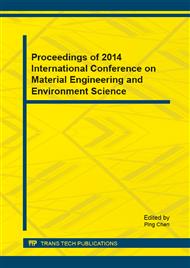[1]
Xunyin Yuan, Yu Wang, Jun Chen, Characteristics of residual organochlorine pesticides in sediments and risk assessment in Taihu lake, J. Environmental Sciences in china, 2003, 24(1): 121-125.
Google Scholar
[2]
Hongyan Zhang, Rutai Gao , Shuren Jiang, The farmland spatial analysis of organochlorine pesticides residues in soil in Beijing, J. Agricultural Science in China, 2006, 39(7): 1403-1410.
Google Scholar
[3]
Xin Zhi, Junfeng Niu , Zhengwu Tang, Typical organochlorine pesticides by the means of ecological risk assessment in the Yangtze river water system in Wuhan section, J. Journal of Environmental Sciences in China.
Google Scholar
[4]
Yiyin Xu, Yinghui Wang and Bing Leng, Characteristics and ecological risk of organochlorine pesticides occurrence in Qinzhou bay sediments, J. Environmental Protection Science in China, 2013, 39(5): 1-4. , 2008, 28(1): 168-173.
Google Scholar
[5]
Meijuan Zheng, Xiaofei Yu, Jiang Wang, Xiaofan Ma, Xianguo Lu, Guoping Wang, The accumulation and purification of pesticide in wetlands. J, Hubei Agricultural Sciences in China, 2013, 52(8): 1737-1742.
Google Scholar
[6]
Vymazal, The use constructed wetlands with horizontal sub-surface flow for various types of wastewater. J. Ecological Engineering, 2009. 35, 11-17.
DOI: 10.1016/j.ecoleng.2008.08.016
Google Scholar
[7]
R. Schulz, Field studies on exposure, effects, and risk mitigation of aquatic nonpoint-sourceinsecticide pollution, Journal of Environmental Quality, 33 (2004) 419.
DOI: 10.2134/jeq2004.0419
Google Scholar
[8]
J. Koskiaho, P. Ekholm, M. Raty, J. Riihimaki, M. Puustinen, Retaining agricultural nutrients in constructed wetlands-experiences under boreal conditions, Ecological Engineering, 20 (2003) 89-103.
DOI: 10.1016/s0925-8574(03)00006-5
Google Scholar
[9]
W. Stringfellow, J. Graham, M. Rogers, S. Borglin, M. Brunell, J. Hanlon, C. Spier, K. Nguyen, Water quality changes occurring in agricultural drains of varying riparian function, Agricultural drainage ditches: mitigation wetlands for the 21st Century. Research Signpost, Kerala, India, (2010).
Google Scholar
[10]
Hong Wang, Lujiu Li, Fengzhong Wang, Shutian Li, Rongle Liu, the application of the agricultural non-point source pollution control in constructed wetlands, J. Journal of Agro-Environment Science in China, 26 (2007) 441-446.
Google Scholar
[11]
Shaoyong Lu, Pengyi Zhang, Gang Yu, The research progress of constructed wetlands processing agricultural runoff, J. Acta Ecologica Sinica in China, 2007, 27(6): 2627-2635.
Google Scholar
[12]
P. Declan, Xunping Qiu, herbicide removal rate quantitative analysis technology in constructed wetlands, J. Express Water Resources & Hydropower Information in China, 2013, 34(8): 18-20, 23.
Google Scholar
[13]
J.C. White, M.I. Mattina, W.Y. Lee, Role of organic acids in enhancing the desorption and uptake f Weathered p, p'-DDE by Cucurbita pepo, J. Environ. Pollut., 2003, 124 (1) : 71-80.
DOI: 10.1016/s0269-7491(02)00409-8
Google Scholar
[14]
H B Runes, P J Bottomley, R N Lerch, A-trazinc rcmcdiation in wetland microcosms , J. EnvironmentalToxicology and Chcmistry, 2009, 20(2): 1059-1066.
Google Scholar
[15]
D Elsaesser, A.B. Blankenberg, A. Deist, Assessing the influence of vegetation on reduction of pesticideconcentration in experimental, surface, flow, constructed wet-lands: application of the toxic units approach[J]. EcologicalEnginccring, 2011, 37(6); 955-962.
DOI: 10.1016/j.ecoleng.2011.02.003
Google Scholar
[16]
C. M. Cooper, M.T. Moore, E.R. Benntt. Inno-vativc uses of vegetated drainage ditches for reducing agricultural runoff, J. Water Science and Tcchnoloiry, 2004, 49(3): 117-123.
DOI: 10.2166/wst.2004.0176
Google Scholar
[17]
Shaoyong Lu, Pengyi Zhang, Gang Yu, The research progress of artificial wetland processing agricultural runoff. J, Acta Ecologica Sinica in China, 2007, 27(6): 2627-2635.
Google Scholar
[18]
Yongmei Li, Hailin Wei, Organic pesticide Nicosulfuron remove on constructed wetlands, J, Journal of Tongji University in China, 2012, 40(10): 1532-1535, 1547.
Google Scholar
[19]
Watanabe H, Grismer M L, Diazinon transport through interrow vegetative filter strips: Micro-ecosystem modeling. , Journalof Hydrology, 2001, 247: 183- 199.
DOI: 10.1016/s0022-1694(01)00385-7
Google Scholar
[20]
Mathew R R. William 'f S. Partitioning of chlorpyrifos tosoil and plants in vegetated agricultural drainage ditches. Chemosphere, 2009, 75: 109- 114.
DOI: 10.1016/j.chemosphere.2008.11.036
Google Scholar
[21]
Guining Lu, Xueqin Tao, Chen Yang, Xiaoxiao Yi, Zhi Dang, Natural degradation of organic pesticides in soil J. Rural Eco-Environment in China, 2006, 38(2): 130-135.
Google Scholar
[22]
Shunpeng Li, Jiangdong Jiang, Microbial remediation of pesticide contaminated soil is reviewed, J. soil in China, 2004, 36 (6): 577-583.
Google Scholar
[23]
Hehui Zheng, Changming Ye, Mobility of acetochlor and butachlor in soil, J. Environmental Sciences in china, 2001, 22 (5 ): 117-121.
Google Scholar
[24]
Zhengjun Shan, Zhonglin Zhu, Xiaomei Hua, mobility of the Aldicarb and other three pesticides in soil , J. Rural Eco-Environment in China, 1994, 10(4): 30-33.
Google Scholar


